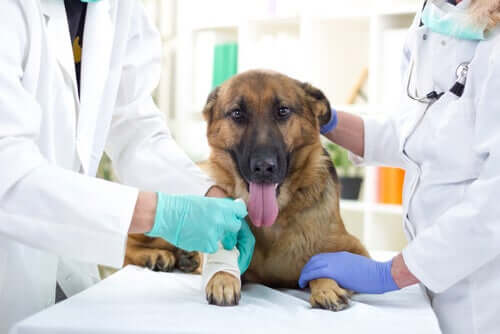Is Chemotherapy for Pets Just as Strong?

Usually, when you think about chemotherapy, terrible images come to mind. Even in chemotherapy for pets, there are unfortunate side effects.
The concept of chemotherapy

In simple terms, we can define chemotherapy as the set of drugs that attack cancer cells. This prevents them from growing and multiplying.
Depending on the type of cancer and the condition of the animal, a veterinarian will choose the appropriate protocol and procedure. A veterinarian will typically use several different measures, including a variety of drugs, removing the tumor before or after chemotherapy sessions, and, in some cases, radiation therapy.
Is chemotherapy beneficial?
A cancer diagnosis in a pet is similar to what happens when a friend or relative is diagnosed with cancer. Some people may have doubts about whether chemotherapy is suitable or not.
We should mention that chemotherapy for pets is different from chemotherapy for humans. The main objective is treating the cancer. However, we also want to avoid endangering the animal’s life.
On the other hand, studies show that dogs and cats tolerate chemotherapy much better than humans.
How is chemotherapy for pets carried out?
In the case of pets, a vet will usually administer chemotherapy intravenously. It can also be given subcutaneously, under the animal’s skin. In some cases, oral administration is even possible, either in a clinic or at home. It all depends on the seriousness of the disease, the characteristics of the animal, and the type of medicine they are taking, etc.
Continuous monitoring of chemotherapy
Before each session of chemotherapy, it’s best that you touch base with the vet and agree on a course of action. Based on the animal’s health and progress, you can decide together if it’s best to continue with the treatment or stop it.
In addition to communicating with you, the vet will also do a complete clinical examination. They will check the animal’s weight, review the size of the tumor, and confirm that the cancer isn’t spreading.
Chemotherapy sessions can take from 30 minutes to an hour. The duration depends on the type of medication. After the session, the animal can go home.
If the chemotherapy is done intravenously, the animal should go to the clinic once or twice a week.
In most cases, a vet can administer chemotherapy without sedation. However, in some cases, such as with certain cats, sedation may be necessary.
Your vet will also probably do blood tests once a week, as well as an analysis of red and white blood count. If these tests show any abnormalities, it’s best to let the animal rest and wait for the numbers improve before the next session.
Some side effects of chemotherapy for pets
Normally, dogs can go through chemotherapy without side effects. However, some sensitive animals may experience gastrointestinal problems, such as diarrhea, vomiting, or loss of appetite. These are usually temporary and subside within a few days. There are even medications to alleviate these effects.
A common side effect that we’re used to seeing in humans is hair loss. For pets, however, hair loss is rare.
Some tips

If your pet is going through chemotherapy, you don’t need to change their lifestyle. You can continue with their daily routines. You should, however, take a few precautions:
- Avoid contact with your pet’s urine, feces, or vomit, especially in the three days following treatment. You should use gloves if you need to pick up or clean up any bodily fluids. If your animal urinates or defecates in the house, you should disinfect the area well.
- If your pet is having chemotherapy orally, you also need to use gloves when administering the pills. Don’t open the pills because this can release gases that are harmful to humans.
